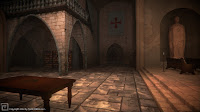
This post has been waiting in the cellar for a long time to come out. And I am glad to finally be able to talk about this production.
Around December 2011
Thor Media LLC was approached by
Joseph James Films to handle the CG and some camera work for their next movie. Called
Templar Nation. A film that runs in the same vein as Indiana Jones with a mix of Nation Treasure.
Our company was, and still is, new to producing good CG. In this case environments. But we jumped on the ball and started to learn about
motion tracking/mach moving and proper
green screen practices. Its funny how these thing work out.


 (Unfortunately, because of bad planning, we had too small of a green screen studio to work with.)
(Unfortunately, because of bad planning, we had too small of a green screen studio to work with.)
Right when we needed the ability to do 3D tracking,
Blender had just been making updates in that direction. Which is something that I am really thankful for, as I have gained quite a liking to the process of match moving.
The film went into full production about mid-January, and finished filming two weeks later.
Jacob,
Bryce, and I was responsible for recording information for match moving, and making sure that the green screen and match moving work was done right, on set. We ran into a slew of problems with this, which I will get into later.





 (I got to do some character design!)
(I got to do some character design!)


Bryce,
Jacob, and I were very much involved with post-production, as you might have already guessed. But due to lack of budget
Bryce and I had to stop working on post production work. This was due to poor pre-production, since most of the design work for CG sets, props, etc., was done in post production. Reducing the amount of time we could actually work on tracking and compostiting.
But regardless of us being involved with pre-production, Jacob continued on, and a final product will be sold to another studio in the near future.


But before I get into the the great things that came out of the project, I would like to talk about some of the road bumps we had during production.
The first thing I learned was, pre-production is a must. Not just for getting a script together, finding locations, finding actors, finding sponsors, etc. But also for CG work. Something we did not have the time or money for, was a storyboard for the CG scenes. Storyboards are essential for CG sequences for various reasons.
First, it will save time in the long run. There is a big difference between going onto a green screen set with a physical picture in your hand of what the shot will look like, and going on set with no idea of what the final shot will look like. The actors and director will obviously have a better idea of what the characters are interacting with. Lighting the scene is actually doable because you have an idea of what the final shot will look like. It is hard to grasp correct lighting when all that you are looking at are green walls.
Another good reason for doing a CG storyboard is that it can help the artist or designer image what should be in the shot. For example. The artist is thinking about adding a balcony to the side of a CG building in a outdoor party scene. If the artist doesn’t know what the shots are, how can he/she know if they will need to design and create a balcony for the building. If you are going to have a balcony in the back ground, should certain details be added to it, like a group of people having a conversation on the balcony.



My point is, is without a storyboard there will be no way to consider certain details that cannot be thought of during shooting. It saves time, money, and headaches for all those involved.
This really was the one thing that made the production very difficult for most of those involved. And because of it, this has become one of my requirements before becoming heavily involved in a large production again.
As you have probably already seen, we worked on everything from full CG environments to props. So overall it was a great learning process that provided some things that we can show off.
Now there are a whole bunch of things I could continue rambling on about this production, but I won’t. I am willing to answer any questions you many have, in the comments.
To close this whole thing up in my mind, I would like to thank Bryce and Jacob with all of their help on the CG end of things. And besides listening to me complain allot, Jacob did the bulk of composting, while Bryce helped me with allot of the design work on the 3D environments.
Without their help we wouldn’t have been able to get out what we did.
We hope, if the movie sells, they will want Thor Media to do another pass on the CG. Because of budget and time, there were allot of sacrifices made to quality. And it would be great for our portfolio, to go through and polish what we have. I’m crossing my fingers.




















